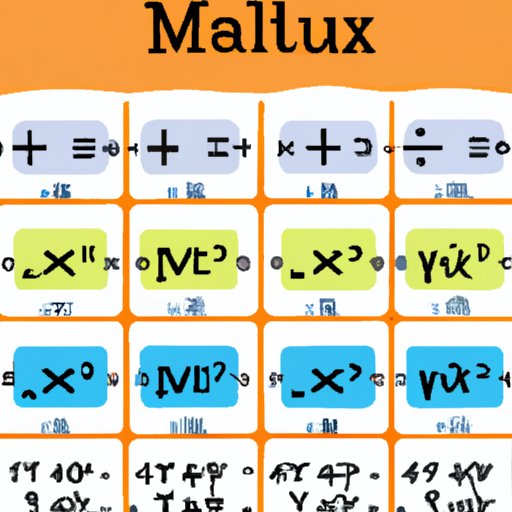Introduction
Partial products are a useful tool for solving multiplication problems. By breaking down numbers into smaller parts, it makes it easier to solve more complex equations. In this guide, we’ll explore what partial products are, how they work, and how they can be used to teach kids about math.

Explaining Partial Products: A Guide
First, let’s take a look at what partial products are and how they can help solve multiplication problems.
What Are Partial Products?
Partial products are a way of breaking down a multiplication problem into smaller parts in order to make it easier to solve. This method is particularly helpful when dealing with large numbers or multiple factors. Rather than trying to calculate the entire equation in one go, partial products allow you to break it down into smaller chunks that are easier to comprehend.
How Partial Products Help Solve Multiplication Problems
Partial products can be used to simplify multiplication problems by breaking them down into manageable parts. For example, if you were trying to multiply 24 and 12, rather than trying to solve the entire equation at once, you could break it down into two parts: (24 x 10) + (24 x 2). This makes it easier to understand and calculate the answer.

Teaching Kids About Partial Products
Partial products can also be used to teach kids about multiplication. By introducing the concept early on, it can help make the subject easier to understand and learn. Here’s how you can incorporate partial products into everyday math lessons.
Introducing Partial Products
When teaching kids about partial products, it’s important to start off by explaining what they are and why they’re useful. You can do this by providing examples of how they can be used to simplify multiplication problems. Once they understand the concept, you can move on to more complex examples.
Incorporating Partial Products into Everyday Math Lessons
Once your students have a basic understanding of partial products, you can start incorporating them into everyday math lessons. For example, when teaching multiplication, you can use partial products to break up larger numbers into smaller, more manageable chunks. This will make it easier for kids to understand and solve the problem.
Breaking Down Partial Products for Beginners
If you’re just starting out with partial products, here are some tips for getting started.
Examples of Partial Products
A great way to get familiar with partial products is to look at some real-world examples. This will help you understand how they work and how they can be used to solve multiplication problems. Here are some examples of partial products:
- 6 x 7 = (6 x 5) + (6 x 2)
- 15 x 12 = (15 x 10) + (15 x 2)
- 20 x 25 = (20 x 20) + (20 x 5)
Step-by-Step Instructions for Calculating Partial Products
Once you’ve become familiar with the concept of partial products, you can start calculating them yourself. Here are the steps you should follow:
- Identify the factors you need to multiply.
- Break up each factor into its individual digits.
- Calculate the partial product for each digit.
- Add up all the partial products to get the final answer.
For example, if you were trying to calculate 24 x 12, you would first break up the factors into their individual digits: 24 = 2 x 10 + 4 x 1, and 12 = 1 x 10 + 2 x 1. Then, you would calculate the partial products for each digit: (2 x 10) + (4 x 1) + (1 x 10) + (2 x 1). Finally, you would add up the partial products to get the final answer: 24 x 12 = 288.

Using Partial Products to Simplify Multiplication
Partial products can also be used to simplify complex multiplication problems. Here’s how:
Identifying Factors to Break Up Multiplication Problems
The first step is to identify the factors that you need to multiply. For example, if you were trying to calculate 24 x 12 x 8, you would need to break up the factors into two-digit numbers: 24 = 2 x 10 + 4 x 1, 12 = 1 x 10 + 2 x 1, and 8 = 0 x 10 + 8 x 1.
Utilizing Partial Products to Simplify Complex Multiplication Problems
Once you’ve identified the factors, you can then use partial products to simplify the equation. For our example, the equation would look like this: (2 x 10 x 0 x 10) + (2 x 10 x 8 x 1) + (4 x 1 x 0 x 10) + (4 x 1 x 8 x 1). Once you’ve broken down the equation into its constituent parts, it becomes much easier to solve.
Conclusion
Partial products are a powerful tool for simplifying complex multiplication problems. By breaking down factors into smaller parts, it makes it easier to understand and calculate the answer. Additionally, partial products can be used to teach kids about math, as it helps make the subject more accessible. So if you’re looking for a way to simplify multiplication problems or teach kids about math, partial products may be the solution you’ve been looking for.
Summary of Benefits of Partial Products
Partial products provide many benefits, including:
- Simplifying complex multiplication problems
- Making math easier to understand and learn
- Helping kids master basic multiplication skills
Final Thoughts on Partial Products
Partial products are a great tool for solving multiplication problems and teaching kids about math. With a little practice, anyone can learn how to use partial products to simplify complex equations and make learning math easier.


